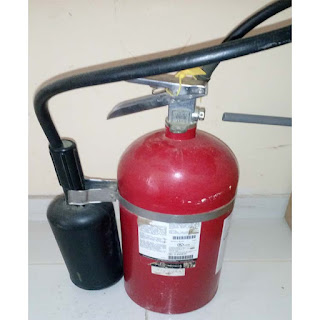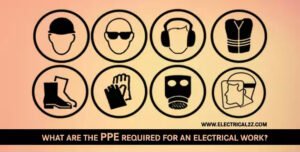Different Types of Fire Extinguisher and Their Uses | All fire extinguishers depends upon two main principles they are, 1. Cooling the fire so that it’s temperature falls below the ignition point and2. Cutting off the access to air.
Types of Fire Extinguisher
The main types of extinguishers in common use are,
1. Soda acid type: It is inexpensive and very commonly used. The chemicals employed are concentrated sulphuric acid kept in a sealed glass bottle and a solution of bicarbonate of soda. When required for the use, hit the handle on the top of the extinguishers sharply.
This breaks the glass bottle inside and the liberated acid mixes with the solution, generating carbon dioxide. Owing to the gas pressure inside the container, the effervescing liquid comes out as a jet or spray which is directed the against the fire. The solution should be renewed at least once every year.
2. Chemical foam type: This is especially suitable for putting out oil fires like transformers, oil switches. The chemicals used are aluminium sulphate and bicarbonate of soda and some special chemicals, kept in separate compartments as solutions. The dry chemicals are supplied in tins by the markers of the equipment. By inverting the extinguisher, the two solutions get mixed up and carbon dioxide is generated.
The liquid issues forth under pressure as foam, i.e. tenacious bubbles containing CO2 carbon dioxide, which can be directed as far as 15 or 20 ft. away. The fire gets quickly extinguished by the blanket of foam, because of the combined cooling action and air supply being cut off. It is thus very effective.
Never throw water on hot oil. The steam generated will burst with explosive violence, Dispersing the hot oil over a wide area and causing further damage.
3. Carbon-tetrachloride: This is the most effective and cleanest form of putting out electrical fires. Since carbon-tetrachloride is an insulator, it may be used on live equipment without any danger of shock. The extinguisher contains a sealed cartridge containing CO2 liquid under great pressure.
By striking a piston the gas cartridge is punctured and a considerable pressure is build-up in the extinguisher, which squirts a jet of carbon-tetrachloride liquid as far as 15 or 20 ft. Carbon-tetrachloride evaporates quickly and smothers the flame effectively. It will not damage any electrical equipment and may be used with complete safety.
It is of course important that the extinguisher itself is of an approved make. Periodical checks and inspections must be carried out to ensure that are perfectly serviceable at all times. Gas-tightness should be ensured. Gaskets should be renewed if required. The chemical charge should be replaced if too old.
Staff should be trained in the correct method of using the equipment, and fire-drills should be held at regular intervals so that the effectiveness of the fire-fighting scheme is fully tested. Keep ready at hand or display prominently on the wall the telephone number of the fire-fighting station.
 |
| Types of Fire Extinguishers |
Classes of Fire Extinguisher
- In Class A extinguisher fires involving solid materials such as wood, paper or textiles.
- In Class B extinguisher fires involving flammable liquids such as petrol, diesel or oils.
- In Class C extinguisher fires involving gases.
- In Class D extinguisher fires involving metals.
- In Class E extinguisher fires involving live electrical apparatus. (Technically ‘Class E’ doesn’t exists however this is used for convenience here)
- In Class F extinguisher fires involving cooking oils such as in deep-fat fryers.
Hope you understand this article about the Different Types of Fire Extinguisher and Their Uses. Incase of any doubt please comment below. Subscribe our website to get every new post update to your email. Please follow our website @ElectricianWorld.Net for future updates. Thank you for visiting our website.


